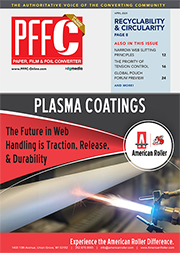Featured Stories
-
Innovation in Extrusion Barriers Can Reduce Brand Owners’ Dependence on Plastic
According to the most recent statistics from the Environmental Protection Agency1, in 2018 the U.S. produced 35 million tons of plastics, while... -
Tension: The First Thing We Must Get Right
Web tension is arguably the most important parameter for any web process. Tension is the first thing we must get right. -
Principles of Narrow Web Slitting
For those veterans in the slitting-winding community, this commentary is not necessarily new information, but reviews are always good too.
News | New Products
-
TIPA Compostable Packaging Appoints John Wilson as Commercial Director for North America
Packaging and sustainability industry veteran joins TIPA, to drive US adoption of compostable packaging to curb plastic waste
-
INX promotes three to Vice President positions
The Board of Directors at INX International Ink Co. have approved the promotions of three key executive managers to vice president positions.
-
Rogelio Barba Villagran Named Business Development Director for AGH Labels North America
AGH Labels, headquartered in Leon, Mexico, is excited to announce long-time executive, Rogelio Barba Villagran, as its business development director for AGH Labels North America.
-
Hong Kong PrintPack Fairs Open in April
Jointly organized by the Hong Kong Trade Development Council and CIEC Exhibition Company (HK) Limited, the two PrintPack Fairs will be April 27-30, 2024 at AsiaWorld-Expo
-
BioEmitter®- Keeping Corrosion and Rust at Bay in Enclosed Spaces
One of the most important missions of Cortec® Corporation, a global leader in the corrosion protection industry, is environmental responsibility.
-
Fedrigoni Names New Commercial Senior Vice President, Chief Marketing Officer
Fedrigoni — the world’s leading manufacturer of specialty papers, premium self-adhesive materials, RFID and connected solutions
-
SEI integrates Vetaphone on new Labelmaster KyoJet
SEI Laser Converting is based in Buja in the northeast corner of Italy.
Expert Advice
Food & Packaging Enjoy!
- Published: September 30, 2004, By David J. Bentley Jr., Contributing Editor
Whether we are meat lovers enjoying a steak or vegetarians enjoying a special lasagna recipe, most of us find eating a pleasant experience.
Steaks, pasta, sauces, chocolate ice cream, etc., can please our taste buds because of the packaging that keeps them in the state in which they provide this optimum taste. The dining process would not be nearly as enjoyable without the benefits of today's food packaging industry and the many positive features the converting industry provides to it.
Eating is pleasant not only because of the flavors imparted by the different foods we consume but also because we are relatively certain we won't get sick. Without proper food packaging, illness from tainted or spoiled food could be rampant. Meat will spoil without protection when exposed to oxygen. Dairy products can become sour without optimum protection. Almost any edible material has a specific shelf life, after which it becomes inedible or at least unpalatable.
Proper packaging ensures food remains at its optimum taste. Specially designed packaging can extend the period over which we can store various food items. Another advantage of food packaging is it helps sustain the nutrients in the food product.
A significant advantage to a flexible food package is that the package is able to comprise many layers. A material that requires protection from light might have a layer of foil in the packaging material. One that requires protection from oxygen might have a coating of a PVDC polymer in the packaging material.
“Active packaging” is a major concern in the converting industry today. The term encompasses what used to be called “barrier packaging” as well as materials and technologies that actually can control and react to events within the package, such as changes in temperature, spoilage, tampering, etc.
Active packaging incorporates special inks or coatings to sense the presence of deleterious materials. A typical example is an ink that will turn a specific color when oxygen enters a package.
One reason this area has come to the forefront is companies marketing food want to provide increasingly more items in their line of products. Some materials need a barrier while others need to breathe. For those items that need a barrier, the barrier may be preventing something inside the package from migrating outside. Alternately, it may mean preventing something outside the package from migrating inside. No single type of barrier package can fit all foods.
Food technologists spend considerable time, effort, and money to ensure the foods available in stores are healthy and tasteful. When their job is complete, the food passes to the next step in the chain of events ending with the consumer. That step is proper packaging to retain all the benefits the food technologist has built into the edible item.
A carrot plucked from the ground may require no additional attention other than an initial washing before it is ready for sale in a grocery store. A snack food such as potato chips always requires careful packaging after manufacture so the product remains crisp, fresh, and tasty after a few weeks of storage on the way to and in the grocery store. Potato chips packaged in PE, for example, would become rancid after a few days and taste terrible. Packing them in a laminated product whose layers were chosen for specific properties of barrier and other concerns allows them to arrive at the point of consumption fully suited to satisfy the consumer.
All the best efforts of the food technologists are to no avail without the proper packaging for the food product they make.
As food manufacturers develop new products to entice consumers, everyone involved in the converting industry must keep abreast of both old and new packaging materials.
A newly developed product food technologists want to promote simply may require a PE film thicker than customary, or it may require a complex coextrusion product comprising many layers of different polymers.
Without proper packaging, consumers will not be able to enjoy their food.

David J. Bentley Jr. is a recognized industry expert in polymers, laminations, and coatings with more than 30 years of experience in R&D and technical service. Contact him at This email address is being protected from spambots. You need JavaScript enabled to view it.













